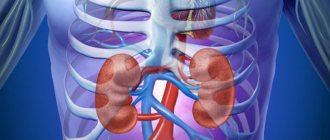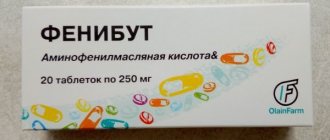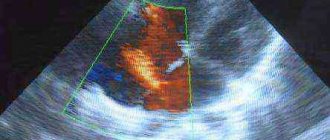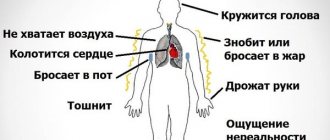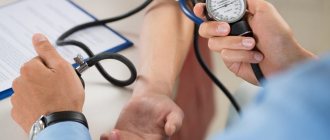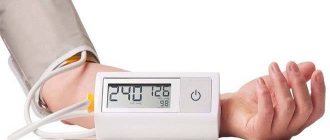- Labile arterial hypertension is a periodic increase in blood pressure.
- Stable arterial hypertension is a persistent increase in blood pressure that requires drug treatment and following a healthy lifestyle.
- Systolic arterial hypertension is characterized by a persistent increase in systolic pressure, while diastolic pressure remains normal or periodically decreases.
According to statistics, about 30% of all cases of arterial hypertension have a labile (unstable) form, which is characterized by frequent changes in blood pressure and periods of its normalization. Patients with this form of the disease are not considered sick, because there is a high probability that over time the blood pressure will recover within normal limits. But in some (cardiologists explain this by hereditary predisposition), labile hypertension can develop into hypertension.
Labile arterial hypertension in adolescents and children
Hypertension is a disease that in recent years has affected not only older people, but also children and adolescents in puberty. With primary (labile) arterial hypertension in adolescents, an increase in blood pressure is periodically observed during the daytime. At the same time, one-time measurements record indicators close to normal, but the child’s blood pressure changes throughout the day. The development of the disease depends on many factors, including genetic, neurohumoral and hemodynamic. The causes of signs of labile arterial hypertension in adolescents may be:
- pathological conditions of the endothelium - a layer of cells lining the internal cavity of the heart;
- overweight;
- kidney diseases (renal artery stenosis, chronic pyelonephritis, glomerulonephritis, etc.);
- disturbances in the functioning of the endocrine system;
- diseases of the cardiovascular system;
- changes in SBP by age (in children from 5 years to 20 years of age).
Systolic blood pressure is one of those significant risk factors whose importance increases with age. In children aged 5 years and older, an increase in SBP is observed, which often takes on the features of labile systolic arterial hypertension. This dynamic can continue during puberty in adolescents. By the age of 20, systolic pressure returns to normal, signs of hypertension disappear and do not disturb the patient until the age of 40, after which SBP increases again. The main criterion for diagnosing labile systolic arterial hypertension is periodic surges in SBP above 140 mm. rt. Art. with diastolic pressure below 90 mm. rt. Art. Over time, the labile form of hypertension can develop into a stable form. This occurs due to age-related changes in blood vessels: the accumulation of calcium and collagen deposits reduces their elasticity and ability to respond to pressure surges. Typically, an increase in SBP worries elderly patients at night and in the morning, children and adolescents - during the day.
Therapy for labile arterial hypertension begins with lifestyle changes: switching to a healthy diet, giving up bad habits, introducing a clear daily routine with periods of proper rest, etc. In some cases, the cardiologist may prescribe small doses of antihypertensive drugs. Treatment with monotherapy is started. If it turns out to be ineffective, complex therapy is used in the form of diuretics, beta1-adrenergic receptor and calcium channel blockers, and sedative herbal infusions are prescribed.
Main reasons
As a rule, experts are of the opinion that arterial hypertension in children and adolescents develops against the background of existing somatic pathologies, for example, kidney disease.
Depending on age, the reasons are as follows:
- in children under one year of age: significant narrowing of the arterioles of the kidneys, thrombus formation in them, congenital structural defects;
- in preschool children: significant changes in the renal vessels, inflammatory processes in the parenchyma of the organ, the formation of Wilms tumor;
- in children 6–10 years old: somatic pathologies of the kidneys of infectious or inflammatory origin, congenital narrowing of the arteries;
- in adolescent patients: diseases affecting both the kidney parenchyma and vascular structures, fluctuations in hormone parameters.
Experts consider the relationship between three main mechanisms in the development of hypertension: along with a significant increase in circulating blood volume, cardiac output increases, as well as total peripheral resistance.
Among the predisposing factors, a careful history taking reveals the following:
- negative hereditary predisposition;
- diabetes;
- childhood obesity;
- high level of anxiety in the child;
- chronic stressful situations;
- diseases of the nervous structures suffered by the baby, injuries.
Rare pathologies that provoke hypertension are systemic vasculitis and connective tissue diseases, endocrine disruptions, and malignant neoplasms. If the root cause of a persistent increase in blood pressure cannot be reliably identified, a diagnosis of “primary hypertension in children” is made. ».
Causes and treatment of hypertension in children and adolescents
High blood pressure does not only occur in older people.
Recently, cases of hypertension in children and adolescents have been increasingly recorded. There are many factors influencing the development of pathology. The risk of developing hypertension in a child increases if close relatives have similar problems. According to statistics, 1-14% of children under the age of 7 years are diagnosed with increased blood pressure (BP). During adolescence, the number of children with hypertension increases significantly. During the first year of life, a child rarely experiences elevated blood pressure.
Blood pressure norms and forms of childhood hypertension
For newborns, normal blood pressure readings are: 71/55 mm. rt. Art. for boys and 66/55 mm. rt. Art. for girls. For children under one year of age, it is possible to increase systolic pressure to 92 mm. rt. Art.
In children from 1 year to 7 years, blood pressure values gradually increase, and by adolescence (16-18 years) they are 100-140/70-90 mm. rt. Art. If the blood pressure exceeds 142 mm. rt. Art.
adolescents are diagnosed with hypertension.
There are two forms of arterial hypertension in children and adolescents:
- Primary hypertension in children: occurs in the absence of a clear cause of the disease.
- Secondary form of pathology: a childhood disease develops against the background of concomitant diseases of the cardiovascular system, abnormalities of the thyroid gland, adrenal function and other diseases.
Causes of the disease and risk factors
There are a number of reasons that provoke a persistent increase in blood pressure and the development of hypertension in a child.
- Chronic intoxication of the body due to infectious diseases. Many diseases in children, which occur in a chronic form and do not cause much concern, provoke a constant intake of toxins into the body, which causes neurotic disorders. Such problems are often the cause of childhood hypertension.
- Taking medications. Frequent use of certain medications can cause an increase in blood pressure. For example, vasoconstrictor drugs for a runny nose in children narrow blood vessels not only in the nose, but throughout the body.
- Hereditary factor (especially on the maternal side). The presence of hypertension in the child's relatives (mother, grandmother) increases the risk of developing childhood hypertension.
- Pathological changes in the autonomic nervous system due to traumatic brain injury.
- Emotional and psychological impact, hormonal disorders. Children's exposure to stress, overexertion, fear, as well as hormonal changes in the body during puberty often cause an increase in blood pressure.
The development of hypertension in children and adolescents is greatly influenced by lifestyle, habits, nutrition, and external conditions. About 70-90% of cases of increased blood pressure in a child are attributed to symptomatic hypertension. Those. indicators increase when symptoms of various diseases appear:
- autoimmune diseases;
- renal vessel stenosis;
- tumor formations;
- coarctation of the aorta;
- obstructive sleep apnea syndrome (OSA);
- dysplasia of the bronchi and lungs.
In 1-2% of children, the cause of hypertension is obstructive sleep apnea syndrome. This diagnosis is made when there is persistent sleep disturbance with cessation of breathing for more than 10 seconds.
Children with chronic ENT diseases (adenoids, tonsillitis), overweight, and structural abnormalities of the facial skull are at increased risk.
In the presence of OSA, the child is likely to develop persistent (malignant) arterial hypertension that cannot be treated.
After 6 years, primary hypertension most often develops. The disease manifests itself in the absence of other pathologies in the body.
The main risk factors for arterial hypertension in children and adolescents include:
- impressionability, emotional and psychological excitability;
- overweight, tendency to obesity, unhealthy diet;
- excessive salt intake;
- inactive lifestyle, frequent watching of TV and computer.
Signs and symptoms of the disease
Arterial hypertension in children develops in several stages:
- Stage IA: short-term increase in systolic value (up to 150 mm Hg) with normal diastolic blood pressure;
- Stage IB: increased systolic pressure (up to 150 mm Hg), in some cases increased diastolic pressure (up to 80 mm Hg), appearance of pain symptoms (tachycardia, headache);
- Stage IIA: a sharp increase in blood pressure to 160-180/90 mm. rt. Art., pronounced symptoms: headache, ringing in the ears, symptoms of left ventricular hypertrophy;
- Stage IIB: persistent increase in pressure, likely development of a hypertensive crisis, deterioration of the condition (vomiting, short-term loss of vision, severe pain in the head);
- Stage III: the patient’s serious condition, not diagnosed in children and adolescents.
Main symptoms of the disease:
- neuro-asthenic syndrome: deterioration of well-being, fatigue, irritability, childish whims;
- hypertensive syndrome: an increase in systolic pressure only, or a simultaneous increase in both blood pressure indicators;
- cardiac symptoms: pain in the heart area, increased heart rate;
- cerebral symptoms: dizziness, vomiting, headaches.
Moderate hypertension in adolescents and children with a slight increase in blood pressure occurs in a normal state without the manifestation of clinical symptoms.
And parents attribute rapid fatigue and irritability to general fatigue of the body, and arterial hypertension in children is not detected in time.
Severe hypertension in childhood and adolescence occurs with a deterioration in well-being and the appearance of pain symptoms.
Diagnosis and treatment methods
The final diagnosis of arterial hypertension in children and adolescents is made after a threefold increase in blood pressure is detected. The first symptoms and signs of the disease can be detected during a regular medical examination with a doctor. Pathological changes are confirmed after daily monitoring of pressure and taking tests with physical and psycho-emotional stress.
Self-prescription of medications for children is strictly prohibited. The dosage and type of medicine can only be prescribed by a doctor, based on examination, test results and examinations.
Moderate childhood hypertension is not treated with medication. In this case, the following actions are taken:
- absence of stressful and negative psycho-emotional effects;
- limiting the child’s time spent on the computer and TV;
- full healthy sleep, adherence to the daily routine;
- nutritional adjustments to reduce excess weight;
- restriction in salt intake;
- appropriate level of physical activity, daily walks in the fresh air;
- giving up bad habits (for teenagers).
Severe hypertension in adolescents is treated mainly with similar drugs that are prescribed to adult patients, only in a lower dosage. The following groups of drugs are used:
- ACE inhibitors and sartans;
- beta-1-blockers (selective drugs);
- calcium channel blockers;
- diuretics (diuretic drugs of plant and synthetic origin);
- sedatives;
- vasodilator medications;
- tranquilizers (if necessary).
With the development of malignant hypertension in adolescents and children due to OSA, treatment with medications is not advisable. This type of pathology is difficult to treat, so it is recommended to consult a somnologist who will help solve sleep problems, normalize blood pressure and improve overall well-being.
Physiotherapeutic methods are widely used in the treatment of hypertension in children and adolescents.
To enhance the body's inhibitory mechanisms (sedative effect), the following are used: electrosleep therapy (activation of brain neurons under the influence of an electrical impulse), electrophoresis, baths with iodine and bromine.
Sodium chloride baths are used to reduce arterial hypertension (hypotonic effect). To stimulate the activity of the heart and blood vessels, the child is prescribed carbon dioxide baths. And to improve blood circulation (vasodilating effect) the following are used:
magnetic therapy, massage of the collar zone, SMT therapy, galvanic collar according to Shcherbak. To restore the vegetative functions of the body, air baths, heliotherapy, and thalassotherapy are used.
After treatment, the patient undergoes a rehabilitation period. It consists of 4 stages:
- early rehabilitation: carried out in conjunction with treatment (physical therapy, medicinal baths, walks in the fresh air, physiotherapy);
- late rehabilitation: treatment in sanatoriums using physiotherapy, massage;
- recovery period: elimination of risk factors for the development of hypertension (adjustment of nutrition, daily routine, excess weight loss, psychotherapy);
- dynamic observation by a cardiologist: regular examination by a doctor is required at least once every 3-4 months for 3 years after recovery.
If left untreated, the following complications may develop:
- organic brain damage;
- convulsions;
- eye disease;
- heart pathologies;
- serious kidney damage;
- cerebral hemorrhage;
- eclampsia.
Treatment prognosis and preventive measures
The effectiveness of treatment depends on the etiology of the disease. Primary hypertension, with timely treatment, ends in complete recovery.
In the absence of proper therapy, the primary form often develops into arterial hypertension in older age.
The secondary form of the pathology often occurs with severe symptoms and is less treatable, but competent treatment and monitoring by doctors reduce the risk of complications.
Measures to prevent the occurrence of arterial hypertension in children and adolescents are carried out from a very early age. Parents should maintain a proper daily routine, provide healthy and nutritious nutrition, and good, restful sleep.
At older ages, it is necessary to exclude risk factors that influence the development of the disease. A favorable and calm emotional environment should be maintained in the family. Children and teenagers should be taught from an early age to walk in the fresh air and have an active lifestyle.
Adults should supervise television viewing and computer gaming time. If there is a hereditary predisposition to the development of hypertension, it is recommended to regularly measure blood pressure in children and adolescents using a special device - a tonometer.
If deviations from the norm are detected in a timely manner, the likelihood of recovery increases.
The appearance of the first symptoms of increased blood pressure in children and adolescents should not go unnoticed. Excessive nervousness, moodiness, and fatigue indicate the presence of certain health problems.
If treatment is started on time, the risk of developing chronic hypertension and serious complications in older age is significantly reduced. A healthy lifestyle, proper nutrition and the absence of bad habits serve as preventive measures for the development of diseases of the cardiovascular system in children and adolescents.
Monitoring blood pressure and regular examinations with a doctor will help identify problems at an early stage and successfully treat the child.
(1 5,00 of 5) Loading...
Source: https://SosudInfo.com/hypertension/gipertoniya-u-detej-i-podrostkov.html
Pathogenesis
The influence of various aggressive factors from the outside or the presence of genetic anomalies and defects in the baby’s body contributes to a failure in the mechanism of autoregulation of pressure parameters.
The balance between cardiac output and total peripheral resistance is disrupted.
It is generally accepted that repeated negative psycho-emotional influences imposed on the child’s personal characteristics can push one to such a state. For example, increased anxiety, suspiciousness. Constant overstrain of the sympathoadrenal system, accompanied by hyperspasm of the smooth muscles of the arterioles, further involves vasoconstrictor factors in the pathological process. An increase in pressure parameters will indicate either an excessive increase in the activity of vasoconstrictors or a depletion of the capabilities of the vasodepressor systems.
Against the background of continued overstrain of the sympathoadrenal system, spasm of the renal vessels is formed, which entails activation of the renin-angiotensin-aldosterone system. It is she who plays the main role in the mechanism of formation of secondary hypertension. Importance is also given to metabolic disorders, for example, metabolic syndrome. Thus, adolescents with persistently high blood pressure parameters and significant obesity are characterized by hyperuricemia, hypercholesterolemia, and hypertriglyceridemia.
Treatment
Treatment of arterial hypertension begins with monitoring the condition of the small patient. The doctor is looking for the causes of the disease. In the early stages of the disease, all clinical recommendations boil down to dietary nutrition and lifestyle changes. If the disease is caused by neoplasms, developmental anomalies and congenital pathologies, surgical intervention is necessary.
Drug treatment has age restrictions. The treatment regimen includes drugs from the following groups:
- diuretics;
- β-blockers;
- ACE inhibitors.
Thiazide and thiazide-like diuretics, such as Indap, Indipam, Lorvas, Hypothiazide, are primarily prescribed. They help compensate for insufficient kidney function and remove excess fluid from the body, lowering blood pressure.
For hypertension in young children, ACE inhibitors are used. They are highly effective and safe for a growing organism. Pediatricians prescribe:
- Accupro;
- Kapoten;
- Diroton;
- Enap.
β-blockers are used in the treatment of hypertension caused by heart disease and congenital organ defects. They are prescribed with extreme caution as they often cause side effects.
Complex treatment with several drugs is rarely prescribed to children. If there is a need for it, the scheme is selected individually.
When choosing medications, the doctor is guided by the patient’s age, weight and the presence of concomitant diseases.
In case of hypertensive crisis, children are prescribed α-blockers and peripheral vasodilators. They can quickly lower blood pressure, but are used only in hospital settings. During their use, the patient must be under constant monitoring by qualified specialists.
ethnoscience
Parents try in every possible way to alleviate the condition of a sick child. Non-traditional methods are also not ignored, because medicinal plants help synthetic drugs to be absorbed faster and strengthen the body’s immune forces.
Cranberries help reduce blood pressure; compotes are prepared from them and consumed raw. Pomegranate and beet juices also have a positive effect on the condition of the heart and blood vessels.
In case of sudden changes in blood pressure, mineral water with lemon juice and honey will help. The ingredients are mixed together and given to the child to drink in one gulp.
The popular indoor plant aloe can reduce blood pressure by 10-15 units. All you need is to drink 50 ml of juice on an empty stomach and wash it down with cold water. The liquid turns out to be very bitter and unpleasant, so children often refuse to swallow it. To improve the taste, honey is added to it.
What is arterial hypertension in children
Each age category has its own physiological parameters, norms of systolic and diastolic pressure. It is especially important to take this into account when measuring blood pressure in children. If, after two or more visits to the pediatrician, a significant deviation in the numbers is revealed that is unexplained by functional reasons, it is recommended to undergo a full medical examination.
Experts usually rely on the following pressure values:
- In infants and children under two years of age, blood pressure of more than 112 mmHg is considered elevated. st;
- In children 3–5 years old, blood pressure of 116 mm Hg is considered high. st;
- at 6–9 years of age, arterial hypertension is diagnosed when the pressure repeatedly exceeds 122 mmHg. st;
- for children 10–12 years old, 126 mm Hg is considered high. Art. and more;
- for adolescents over 13–15 years of age, hypertension is fixed at 135 mm Hg. Art.
For children after reaching 16–18 years of age, pressure parameters are considered as in the adult category of patients. And hypertension is diagnosed when blood pressure persistently remains within the range of 142–149 mm Hg. Art. and higher. Adequate comprehensive treatment is prescribed at the earliest stage of the development of primary hypertension in children in order to avoid severe complications and consequences.
How does essential hypertension develop in adolescents against the background of strong emotional experiences?
- First, due to negative psycho-emotional stress, the excitation of the sympathetic centers increases.
- Due to spasms of resistive vessels and continuously high levels of peripheral vascular resistance, hypertension occurs in adolescents.
- Then hypertrophy of muscle cells occurs.
- The lumen of resistance vessels begins to narrow.
- The wall of blood vessels, on the contrary, thickens.
- As OPSS takes on a character, arterial hypertension in adolescents becomes irreversible and most often malignant.
What complications can arterial hypertension lead to at a young age:
- pericarditis;
- endocarditis.
Symptoms of the disease in preschool children
In most cases, at the early stage of development of hypertension in children, it is asymptomatic. Deviations in pressure parameters are detected by chance, for example, during a preventive medical examination in an educational institution. With a slight increase in pressure, the baby’s well-being remains good: he plays, studies, without feeling any discomfort. Less often, parents are alarmed by increased fatigue of the baby, excessive irritability, and decreased appetite. But the relationship with fluctuations in pressure parameters is not established.
At an advanced stage of the disease, health problems become obvious. In addition to pain impulses in the head that vary in intensity and localization, the baby is bothered by dizziness, nausea, rapid heartbeat and chest discomfort. Frequent fainting conditions, tinnitus, and flickering of spots before the eyes may occur. Physical and intellectual activity decreases.
The malignant course of arterial hypertension is often accompanied by renal diseases; it is characterized by a persistent increase in pressure parameters. The effectiveness of the ongoing treatment measures is low. The risk of death from severe complications is extremely high.
What are the causes and symptoms of hypertension?
Arterial hypertension is a serious cardiovascular disease that kills millions of people around the world every year. With this disease, a person has consistently high blood pressure. His scores are over 140/90.
Hypertension negatively affects the functioning of blood vessels. High pressure in them leads to gradual narrowing and damage to the walls. Powerful blood flow often leads to the vessel bursting, causing hemorrhage. This condition threatens a heart attack, and not only a heart attack. Any organ whose vessels have lost elasticity is at risk.
The causes of hypertension are varied. It often affects people who often experience severe emotional turmoil. For example, if a person’s work is associated with psycho-emotional stress and stress, the risk of developing a disease increases.
Hypertension is experienced by people who have suffered traumatic brain injuries. Heredity is also included in the list of risk factors.
When considering the causes of hypertension, you need to pay special attention to physical inactivity, which is typical for older men and women. Many older people develop atherosclerosis. Hypertension only aggravates the manifestations of this disease. This situation threatens a person’s life, because with a powerful spasm of blood vessels and the presence of plaques in them, the nutrition of organ tissues (brain, lungs, heart) is disrupted, which causes a heart attack or stroke.
Hypertension often occurs in women over 40 years of age. At this stage of life, hormonal changes begin, associated with the gradual decline of ovarian function. Hormone imbalances cause many diseases, including hypertension.
People who lead an unhealthy lifestyle are at risk of developing the disease. If a person eats poorly, moves little, consumes a lot of salt, smokes and drinks large doses of alcohol, his body is destroyed from the inside. First of all, due to growing body weight, the load on the blood vessels increases, which leads to an increase in blood pressure. However, due to insufficient training, the vessels weaken, which is why they react poorly to increased pressure.
With poor nutrition, a person's blood cholesterol levels increase. Because of this, plaques form on the walls of blood vessels, which interfere with their normal functioning. Due to poor lifestyle choices, hypertension often occurs in young men and women.
It has been noted that taking oral contraceptives increases the risk of hypertension in young women. Diet pills and strong anti-inflammatory drugs also often cause high blood pressure.
At a young age, men are more at risk of developing the disease, as their sex hormones provoke a rise in blood pressure. A man's body weighs more than a woman's body. This causes an increase in the load on the blood vessels, which leads to hypertension.
Diabetes mellitus is included in the list of provoking factors for the development of hypertension. A high concentration of glucose in the blood has a destructive effect on human blood vessels, causing them to become less elastic and react poorly to the slightest deviation in pressure.
Symptoms
Signs of hypertension depend on the severity of the disease. It usually proceeds slowly.
- In the first degree, a person experiences the first rise in blood pressure, but usually they do not exceed 160-180 mmHg. Art. and 95-104 mm Hg. Art. Blood pressure constantly fluctuates during physical and emotional stress, but at rest it normalizes. At this stage, the patient notices frequent headaches, decreased stamina, and sleep disturbances. Nosebleeds are often observed.
- In the second degree, the pressure exceeds 180 to 105. This condition is stable, which causes a hypertensive crisis.
- The third degree is the most difficult. Irreversible processes occur in the body, for example, the destruction of arterioles. Blood pressure may exceed 220/120.
At the initial stage, there may be no symptoms of hypertension. The patient feels a headache due to constant spasms of the blood vessels in the brain, and also experiences obsessive tinnitus, pain and darkening in the eyes. A person suffers from frequent dizziness, weakness, and sleep disorders. At the initial stage of hypertension, people's emotional state is also unstable. Due to poor health, the patient often experiences anxiety, irritation, and apathy. Headaches can cause nausea and vomiting.
With a sharp increase in blood pressure, the face of a hypertensive person turns red and sweating increases. Because of this, productivity decreases. Sometimes patients experience unpleasant pressure in the eye area.
As the disease progresses, a person's vision decreases. High blood pressure leads to the destruction of blood vessels in the brain, which increases the risk of stroke. The development of hypertension leads to vascular thrombosis.
The severity of complications depends on the age of the sick person. It is noteworthy that young people have a higher risk of severe complications than adults and the elderly. Men suffer from hypertension more severely than women.
First of all, a person should measure their blood pressure regularly. If at least several times its indicators exceed the norm (130 to 80 for young people, 140 to 90 for adults and the elderly), you should immediately consult a doctor.
To protect yourself from the disease, you need to monitor your emotional state and body weight. Adequate physical activity and proper nutrition minimize the risk of hypertension. If a person has diseases that provoke this disease, he needs to constantly monitor his health and undergo regular examinations.
Symptoms of hypertension in adolescents
The period of a child’s life when significant fluctuations in hormone parameters, rapid growth of all parts of the body and maturation of brain structures occurs, is often accompanied by surges in blood pressure. However, if, when visiting a specialist, the systolic pressure figures were two or more times higher than 140 mmHg. Art., and diastolic were 90–100 mm Hg. Art., a mandatory additional examination is required to exclude established primary hypertension.
The problem of teenage hypertension is relevant today. Every year, an increasing number of children aged 10–15 years whose blood pressure monitoring has revealed a persistent increase in blood pressure are seen by a specialist. Symptoms, as a rule, are nonspecific: periodic headaches, moderate weakness, increased irritability, fatigue, so they are mistaken for manifestations of other diseases and conditions. For example, for overwork from schoolwork.
In the absence of adequate medical care, a mild degree of pathology, which goes unnoticed for a long time, becomes persistent. It will be accompanied by regular headaches, persistent dizziness and significant memory impairment. In addition, the teenager is bothered by periodic discomfort in the left half of the chest along with increased heart rate and shortness of breath.
Almost any physical or intellectual stress leads to a sharp deterioration in well-being and the following symptoms appear:
- unbearable headaches;
- frequent nausea, vomiting;
- sudden deterioration of vision;
- convulsive contractions of the body;
- loss of consciousness.
If any of them appear, emergency medical attention is required.
How not to miss the appearance of arterial hypertension
You should start measuring your child’s blood pressure at 3 years old (before kindergarten), then at 5-6 years old (a year before school), at 6-7 years old (before school), 7-8 years old (after finishing first grade), and then every year. If any disturbances in the functioning of the heart, kidneys or heart appear, it is necessary to take the child to the doctor. They will undergo diagnostics. The doctor will prescribe treatment for the child, which will help cope with the disease in a short time. Timely contact with a specialist and treatment will reduce the risk of transition from mild to severe hypertension.
How to measure pressure correctly:
- Blood pressure should be measured at the same time every day, preferably in the morning.
- You should start measuring blood pressure only after the child has sat quietly in a chair with a straight back for about 5 minutes.
- The middle of the cuff that will be placed on the shoulder should be located at the level of the teenager's heart.
- The measurement must be taken 3 times. The interval between them should be at least 2-3 minutes.
- Pressure should be measured for right-handed people on the right hand, and for left-handed people - on the left.
Which doctors should you see to get an accurate diagnosis:
- pediatrician;
- ophthalmologist;
- neurologist;
- cardiologist;
- endocrinologist
What examinations need to be completed:
- daily blood pressure measurement;
- ECG;
- echo ECG;
- physical and emotional tests (bicycle ergometry, as well as a special TV game);
- chest x-ray;
- excretory urography.
In addition, the child will have to undergo urine and blood tests, and an ophthalmologist will conduct a diagnostic examination of the fundus. The brain, lungs and kidneys may be examined. It includes ultrasound as well as x-ray techniques. Hypertension in children can only be diagnosed after a comprehensive examination.
Diagnostics
A simple measurement of pressure parameters using a tonometer allows one to suspect the onset of hypertension in preschoolers and adolescents. To perform the manipulation, no special knowledge or skills are required: modern models of devices allow you to perform all actions according to simple instructions.
However, a single detection of high numbers does not mean that the baby already has the disease. There is such a thing as “white coat syndrome,” when a child experiences fear of the doctor, worries, and blood pressure increases. Therefore, it is recommended to repeat the procedure twice more. This measure avoids overdiagnosis. A physical examination - anthropometry, palpation, auscultation - allows us to identify deviations in the physical development of the baby, the presence of predisposing factors, for example, obesity.
The leading role in the early diagnosis of hypertension is given to a thorough history taking:
- family: blood relatives and parents already have pathologies of the cardiovascular system;
- personal: previous injuries, infectious diseases of the kidneys, heart, brain;
- pharmacological: long-term use of certain subgroups of medications that have the ability to negatively affect blood pressure parameters.
Laboratory and instrumental studies are carried out for differential diagnosis with other diseases accompanied by increased pressure:
- daily blood pressure monitoring;
- blood tests - general, biochemical;
- Ultrasound of the kidneys, thyroid gland, adrenal glands;
- study of hormone parameters;
- ECG, ECHO KG;
- glucose tolerance test.
Only complete information will allow a specialist to make an adequate diagnosis.
VSD in a teenager. Severity of symptoms, diagnosis of the disease and adequate therapy
During puberty, a teenager's body undergoes hormonal changes. During intensive growth, some body systems may not “keep up” with others, and then symptoms of VSD appear in adolescents. VSD of puberty manifests itself during adolescence, when hormonal changes occur.
Reasons for deviations
It is not always easy to determine why VSD appears in adolescents; the causes and symptoms differ from child to child. Usually the cause is a lag in the development of the peripheral nervous system from the growth of the body. It is based on disturbances in the functioning of the nervous and cardiovascular systems. Weak nerve impulses are formed, which has a negative effect on the functioning of blood vessels. The age when pronounced symptoms of VSD appear in a teenager is 14 years.
The main factors leading to VSD:
- changes in hormonal levels;
- lagging growth of the circulatory system and blood vessels from the growth of muscles and skeleton, leading to a deficiency of blood supply to organs;
- past infectious diseases;
- injuries;
- toxic effects of bad habits;
- stressful situations;
- heredity.
Symptoms of dystonia
The first signs in boys and girls are observed at the age of six. When hormonal changes occur, VSD during puberty acquires a pathological course in a teenager.
According to ICD-10, dystonia has no classification and is not classified as an independent disease; it is characterized as a disorder in the functioning of the nervous and vascular systems.
There are several types of dystonia:
- Hypertensive. Blood pressure and heart rate increase. The teenager is worried about panic attacks and a state of overexcitement. Such phenomena are observed during physical activity and at rest.
- Hypotonic. Characterized by decreased blood pressure, increased fatigue, lethargy and apathy.
- Cardiac. Accompanied by disturbances in the functioning of the heart, arrhythmia and heartbeat irregularities.
- Mixed. The most severe form is when the child is alternately disturbed by changes in blood pressure, and the state of overexcitation is replaced by hyperinhibition.
How do VSD symptoms manifest? In adolescents, symptoms of concomitant abnormalities:
- changes in body temperature, expressed as an increase or decrease for no apparent reason;
- increased sweating;
- freezing hands and feet;
- increased irritability and anxiety;
- digestive disorders;
- headache, fainting and dizziness;
- pallor, followed by flushes of blood to the face;
- arrhythmia, tachycardia and breathing difficulties.
Dr. Komarovsky about VSD:
Diagnosis of vegetative-vascular dystonia
During the examination, the teenager visits specialists, which makes it possible to get a general picture of the state of the body and identify deviations. This approach allows you to prescribe comprehensive treatment and normalize the child’s well-being.
Among the examinations are:
- Ultrasound diagnostics of the heart, thyroid gland and brain;
- blood tests;
- blood pressure control;
- MRI of the brain.
The examinations carried out make it possible to find out the cause of VSD in a teenager. Based on the results of ultrasound, MRI and tests, the doctor will prescribe medications.
Drug treatment
There are no special medications for the treatment of VSD in adolescents. The use of medications from different pharmacological groups makes it possible to relieve the symptoms of vegetative-vascular dystonia. Treatment is aimed at eliminating vascular and neurological disorders.
The optimal set of medications for the treatment of VSD in adolescents should be prescribed by a doctor. Treatment includes the following medications:
- Sedatives. Motherwort and valerian stabilize the functioning of the nervous system.
- Tranquilizers. Afobazole and adaptol help with severe nervous disorders.
- Sleeping pills. Donormil and Melaxen will improve sleep and relieve a teenager from insomnia.
- Nootropics. Glycine, piracetam, cinnarizine improve blood circulation and increase concentration.
- Antihypertensive drugs. Normalizes high blood pressure.
- Antihypotonic agents. Tinctures of ginseng, Rhodiola rosea and Schisandra increase blood pressure in hypotensive patients.
- Vitamins and minerals. They have a general strengthening effect on the body.
You should not take medications containing alcohol. Almost all medicinal tinctures have analogues in tablet form. Even small doses of alcohol are undesirable at this age.
Only a specialist can select medications. It is unacceptable to self-medicate. Taking into account individual symptoms, the doctor will draw up a treatment plan. This approach allows you to quickly alleviate the child’s condition and get rid of the disease. The doctor will advise how to treat VSD in a teenager, how long to take the pills and give additional recommendations.
The duration of treatment depends on how timely therapy is started and the severity of symptoms. Most often, therapy lasts no more than six months. The duration of medication support should be discussed by an adult with the attending physician.
Additional treatments include physical therapy:
- electrophoresis with novocaine relieves heart pain, procedures with magnesium sulfate reduce high blood pressure, with caffeine they help increase it;
- acupuncture tones the body, gives energy and increases stamina;
- physical therapy strengthens the body and normalizes the functioning of the nervous system;
- acupressure, water procedures and swimming increase muscle tone and increase blood circulation.
Teenage lifestyle
During treatment, special attention should be paid to the child’s daily routine and activities.
- Compliance with the regime.
A teenager needs eight hours of sleep. This duration allows the body to rest and recover for a new day. Frequent or persistent sleep deprivation worsens symptoms with increasing intensity.
During the day, alternate between physical activity, mental activity and rest. This approach will avoid overwork and speed up the disappearance of VSD.
- Sports loads.
Physical education and sports keep the body in good shape and stimulate blood circulation. Cardio exercises, running, table tennis, tennis, and swimming are suitable. It is better to postpone vigorous types of exercise during treatment.
- Balanced diet.
Healthy foods rich in nutrients, vitamins and minerals will provide everything the actively growing body needs and speed up recovery. When creating a menu, the best choice is simple foods high in quality protein. Fresh vegetables and fruits will saturate the body with useful substances and normalize digestion.
General recommendations
Early identification of a child’s tendency to increase individual age-related blood pressure figures makes it possible to carry out a number of measures to eliminate provoking factors and prevent the transition of the disease to the second or third stages.
During consultation, specialists recommend adhering to the following preventive measures:
- avoid severe, chronic stressful situations; timely notice changes in the baby’s behavior, find out the cause and eliminate it;
- minimize watching television and communicating with the computer;
- adjust work and rest schedules, ensure quality night sleep;
- in order to normalize weight parameters, review the diet: it should be dominated by vegetable and fruit dishes, cereals, and herbs;
- minimize the amount of salt consumed daily;
- physical activity must be adequate and age appropriate;
- a teenager’s refusal to give up negative habits if he already has them.
Along with the above recommendations for the lifestyle of a child prone to hypertensive crises, the specialist recommends various physical procedures, massage courses, and herbal medicine: taking healing soothing teas, infusions, and decoctions. Aromatherapy and acupuncture, relaxation techniques are popular.
Therapy methods
In order to correctly diagnose and prescribe treatment, it is necessary to find out exactly what factors influenced the development of arterial hypertension in a child. You need to understand: high blood pressure is a consequence of illness or poor lifestyle.
Thus, blood pressure may increase for a short time if it is caused by nervous strain, obesity or bad habits. In this case, there is no need to reduce it with medications. If an increase in blood pressure in a teenager occurs due to dysfunction of the kidneys, heart or blood vessels, then drug therapy will be required.
Principles of treatment of essential arterial hypertension:
- cessation of smoking and drinking alcoholic beverages;
- compliance with a regime in which work and rest will be evenly distributed;
- increased physical activity;
- eliminating large amounts of salt from food;
- weight loss with a special diet;
- assisting the child in dealing with stressful situations (if necessary, visiting a psychologist with him).
You can cope with attacks of high blood pressure using the following procedures:
- message;
- sulfide and carbon dioxide baths;
- relaxation techniques;
- physiotherapy;
- phytotherapy;
- reflexology;
- healing shower.
Pharmacotherapy
If non-drug measures recommended by a specialist - diet therapy, correction of work schedule, a good night's rest, reducing intellectual load at school - do not bring noticeable positive results, the selection of modern antihypertensive drugs is required. The doctor analyzes all the information about the results of the diagnostic measures carried out, since today the pharmacological market offers hundreds of medications that have different mechanisms for lowering blood pressure.
The age category of the child, the characteristics of his body, the presence of other somatic pathologies, general susceptibility to medications, allergic conditions must be taken into account. As a rule, effective drugs recommended today by specialists for the correction of hypertension belong to the following subgroups:
- beta blockers: have the ability not only to lower blood pressure, but also to slow down the heartbeat;
- ACE inhibitors: the latest generation of medications have hypotensive and cardioprotective, as well as nephroprotective effects;
- angiotensin receptor blockers: in addition to lowering blood pressure, they have an organoprotective effect;
- calcium antagonists: can be used in children over 6–8 years of age;
- diuretics: treatment is carried out under strict control of the parameters of the urinary structures.
Self-medication is unacceptable. The selection of adequate pharmacotherapy is carried out only by a specialist.
Labile arterial hypertension - what is it and how to treat it?
This disease ranks first in popularity among pathologies associated with the heart and blood vessels.
Labile arterial hypertension can be diagnosed in both adults and children. What triggered the onset of the disease can only be said by a doctor after the examination results.
There are treatment methods, but first you need to establish the root cause and eliminate it as quickly as possible.
Blood pressure lability - what is it?
The definition of “lability” (labilis) is translated as “unstable”, “sliding”. Based on these definitions, the medical term “labile arterial hypertension” appeared. The pathology is associated with unstable blood pressure.
Dependence of blood pressure on external factors
What is labile arterial hypertension?
With this disease, unstable blood pressure is always present. In simple terms, this is a type of hypertension in which blood pressure suddenly rapidly “increases” to levels of 140 over 100, and after some time normalizes without the use of any medications. Further, the situation may repeat again and again, while symptoms may not appear.
Despite the fact that the pressure stabilizes on its own, the disease cannot be started, since with each increase in indicators the condition of the vascular walls worsens. Therefore, deviation requires special attention and assistance from a specialist.
Despite the temporary nature of high blood pressure, it should not be ignored.
Symptoms
Very often the disease proceeds without any side effects, but some patients may experience characteristic signs of hypertension. Such as:
- Sleep disturbances and excessive anxiety;
- Regular mood swings;
- Headaches in the occipital region;
- Redness of the facial skin;
- Difficulty breathing (including shortness of breath).
Often, with labile hypertension, the patient’s limbs go numb due to circulatory failure. Many also complain of loss of performance and absent-mindedness. Without proper treatment, symptoms will increase and your health will worsen. The longer a visit to the doctor is delayed, the more serious the consequences.
If symptoms appear, you should consult a doctor so as not to worsen the situation.
Causes
All the reasons that could influence the occurrence of the disease have not been studied to this day. But experts say that in the vast majority of cases, pathology is a consequence of:
- Frequent severe stressful situations;
- Consumption of salt and coffee (in large quantities);
- Overweight;
- Abuse of alcoholic beverages and smoking;
- Lack of sufficient physical activity;
- High cholesterol levels.
Also, pressure lability can appear as a consequence of hormonal changes in the body, for example, during pregnancy, adolescence, or during menopause in women.
Note. The highest risk group includes people with a genetic predisposition. Therefore, if there are people in the family with labile hypertension, for prevention purposes you should regularly visit your doctor.
Main phases
In medicine, labile arterial hypertension is divided into 2 stages:
- Phase A is the initial stage of development of the pathology, in which blood pressure levels can remain normal for quite a long time. An increase may occur suddenly after suffering stress or physical overload.
- Phase B is defined as transient. Blood pressure surges occur more often, but then the pressure returns to normal, usually without any medications.
In the early stages of labile hypertension, corrective medications are not required
Another division of this pathology defines three stages of labile hypertension:
- Initial. In most cases there are no symptoms, and the disease can develop over many years. This causes damage to blood vessels and the heart muscle, and also significantly increases the risk of stroke and dangerous pathologies of the cardiovascular system.
- Average. The symptoms become more pronounced than in the first stage, but still remain barely noticeable. If the patient consults a doctor in time, studies may show a blood pressure level close to moderate hypertension. At this stage, pathological changes occur in the arteries and left ventricle of the heart.
- Heavy. In severe forms, blood pressure increases very often, and the symptoms already become characteristic of labile hypertension. At this stage, patients often develop vascular atherosclerosis and blood circulation is impaired. The danger is that a hypertensive crisis can occur at any moment.
In addition, there is such a term as labile systolic hypertension. The disease is caused by an increase in only the upper indicators. Diastolic blood pressure remains normal.
Danger of the condition and consequences of the pathology
The danger lies in the fact that until symptoms appear, the patient is unaware of the development of the disease, and at that time pathological changes are already progressing in the body. The consequences can be quite serious:
- Stroke and heart attack;
- Hypertensive crisis;
- Brain pathologies.
In this case, the main thing is to recognize the disease as soon as possible, consult a doctor, and begin a timely course of treatment. This will minimize the risk of developing dangerous diseases.
Diagnostics
To begin with, the doctor conducts a thorough visual examination of the patient and collects complete information (lifestyle, presence of bad habits, whether there are people in the family with this pathology, etc.). Further, to make a diagnosis, 24-hour blood pressure monitoring will be required.
Based on the data obtained, the doctor will be able to determine whether pathology is present in the patient’s body. If this examination becomes insufficient, then additional diagnostic measures may be prescribed, for example, ECG (electrocardiography) and other specific studies.
You may need to do an ultrasound of the kidneys and thyroid gland
Treatment
Therapeutic measures are usually based on lifestyle adjustments. First of all, the patient should pay attention to the food consumed. Doctors recommend:
- Eat more berries, fruits, fresh vegetables;
- Reduce consumption of salt, coffee, confectionery;
- Add fermented milk products and meat (lean) to your diet;
- Avoid drinking coffee and strong tea;
- If you are overweight, reduce portions and divide meals into 4-5 times.
If the increase occurs due to stress, you can resort to the help of sedatives, for example, motherwort tincture or Glycine. In case of blood pressure surges due to a sedentary lifestyle, it is necessary to increase physical activity and play sports.
Note. If these measures are not enough, then drugs with a hypotensive effect, diuretics and other drugs may be prescribed to eliminate the disease. But any prescription can only be made by a doctor.
Prevention
Often, preventive measures help prevent blood pressure surges. To do this you need:
- To refuse from bad habits;
- Rest more;
- Avoid stress;
- Exercise;
- Eat healthy foods;
- Control body weight;
- Make time for proper sleep.
If you don’t have time to play sports, you can visit the pool from time to time or take a contrast shower more often, as well as relaxing baths with essential oils.
A healthy lifestyle prevents most diseases
Labile arterial hypertension in children and adolescents
Often the pathology occurs in children and adolescents aged 5 to 20 years. It may appear due to:
- Excess body weight;
- Pathologies of the heart and blood vessels;
- Dysfunction of the endocrine system.
Unfortunately, high blood pressure in children is not uncommon.
The disease may be accompanied by poor health, heart pain, excessive irritability and sleep disturbances. To avoid complications, you should consult a doctor when you notice the first symptoms. He will be able to determine the severity of the pathology and prescribe the correct treatment.
Do they take you into the army?
The disease is a mild form of hypertension and is characterized by a short-term increase in blood pressure, therefore, when diagnosed with labile arterial hypertension, one is drafted into the army. If the disease has reached a chronic stage and the elevated blood pressure is permanent, then after examination the teenager is diagnosed with hypertension.
The disease is, of course, serious, but if you follow the doctor’s recommendations, the prognosis is favorable. A timely course of therapy prevents the risk of developing various pathologies. If everything is done correctly, the probability of developing hypertension is less than 20%.
Source: https://gipertonia.guru/arterialnoe-davlenie/obshhaya-informatsiya/labilnaya-arterialnaya-gipertenziya/
Help with a hypertensive crisis in a child
An acute attack of hypertension - a crisis - occurs at any time. Therefore, it is recommended to find out in advance what actions need to be taken in this case, how to make the child feel better. A gentle gradual decrease in pressure parameters can be achieved as follows:
- create a calm environment, move the baby to a dark, cool room with minimal noise;
- unbutton restricting clothing, free from belts and waistbands;
- place a towel soaked in cold water on your forehead and a heating pad with hot water under your feet;
- it is permissible to wet a piece of cloth in a solution of table vinegar, which is then placed on the heel area for 15–20 minutes;
- if a surge in pressure is provoked by emotional stress, it is necessary to give the baby “Glycine”, or valerian, motherwort - in the doses recommended by the doctor during the consultation;
- in case of severe hypertension, stronger drugs will be required: Nifedipine, Captopril. They are taken half a tablet under the tongue, but it is also better to coordinate such actions with a specialist.
In the absence of a positive effect, when the pressure remains high for a small patient, it is recommended to seek medical help. After assessing the child’s condition, emergency medical personnel will administer antihypertensive drugs in injectable form according to the existing disease and age parameter. If necessary, other symptomatic therapy will be carried out: relief of seizures, pain in the heart area, shortness of breath.
Methods for diagnosing adolescent hypertension
To establish an accurate diagnosis as quickly as possible, the doctor prescribes a series of diagnostic procedures. Typically this is:
- General blood and urine tests;
- Blood chemistry;
- 24-hour blood pressure monitoring;
- Ultrasound of the heart and/or kidneys;
- Electrocardiogram and/or echocardiogram.
To assess the vascular system, specific studies may be prescribed, including Doppler ultrasound. The teenager may also be referred for consultation to a neurologist, endocrinologist and other highly specialized specialists.
A thorough diagnosis will allow you to prescribe effective treatment
Diet therapy
An important role in the complex treatment of hypertensive pathology in children and adolescents is given to adherence to the principles of diet therapy. The daily diet should be dominated by vegetable and cereal dishes, as well as fruits. You will need to give up salt, spices, and sauces. Experts are of the opinion that if you are prone to high blood pressure, it is better to minimize meat dishes and baked goods, as well as sweets and confectionery products.
Microelements such as potassium and calcium, magnesium and sodium bring enormous benefits to the body of hypertensive patients. In proper quantities, they help to relax spasmodic vessels and reduce peripheral resistance in them, which has a beneficial effect on pressure parameters. There are especially many of the listed nutrients in foods such as dried apricots and raisins, prunes and pumpkin seeds, almonds and walnuts. Brussels sprouts and celery, mushrooms and beans, and oatmeal have proven themselves to be excellent for hypertension.
The diet must also contain polyunsaturated fatty acids. They have the role of improving the elasticity of blood vessels and increasing their resistance to crises. Their optimal amount is in olive oil, salmon, halibut, and other fatty fish. In the summer, the child is given blueberries and strawberries, citrus fruits, if there is no allergy. Water regime is also important: you need to drink at least 1–1.5 liters of water daily. These can be fruit drinks, compotes.
How does the disease manifest itself?
Doctors and parents discover symptoms of hypertension in teenagers by chance. Children aged 12-16 years are not used to complaining about being unwell. Considering themselves already adults, they carefully hide their deteriorating health, mistakenly believing that they can handle their problems themselves.
Signs of high blood pressure in teenagers are as follows:
- headaches and fainting often occur;
nosebleeds;
- general weakness;
- chest pain;
- increased nervousness and insomnia are noted;
- balance is disturbed and dizziness, which is very noticeable during physical education;
- the patient blinks frequently, as he experiences black flies flashing before his eyes, and his vision decreases.
If blood pressure increases due to excess weight or salt abuse, the teenager's limbs swell in the morning. The face may also become red and short of breath. If you notice such symptoms, you should consult a doctor as soon as possible.
The duration of treatment for adolescent hypertension and its results directly depend on the speed of parents’ actions.
Complications and consequences
Severe arterial hypertension, frequent crises, persistent maintenance of individually high pressure parameters - all this contributes to the formation of such complications and consequences as:
- death of a section of the heart muscle – myocardial infarction;
- damage to the renal structures - nocturia or polyuria;
- disasters in nervous tissue - strokes, memory impairment, decreased performance;
- hypertensive form of retinopathy – narrowing of retinal vessels, hemorrhages, blindness;
- the most severe complication is death: against the background of a crisis, acute ventricular failure and cardiac arrhythmias occur, leading to a sad end.
In order to prevent the above-mentioned consequences and complications of hypertensive pathology, experts urge parents to be more attentive to the health of their children, promptly pay attention to the deterioration of their well-being, and seek medical help.
Symptoms
Arterial hypertension in children at the initial stage may not have clinical manifestations, which is why the child and his parents often do not suspect the presence of a problem. Nonspecific symptoms are often present: headaches, dizziness, decreased performance, irritability. When examining a child, the doctor may indicate excess body weight and the presence of autonomic disorders.
With severe hypertension, headaches and dizziness intensify, which worsens the child’s quality of life. Symptoms include memory impairment, tachycardia and heart pain. As hypertension progresses in adolescents, complaints of decreased visual acuity appear, especially during increases in blood pressure; Fainting is sometimes observed.
Young children are not able to report a deterioration in their condition, so parents need to be attentive and pay attention to features that indicate illness. The symptom is shortness of breath that occurs during feeding. The problem is indicated by insufficient weight gain and delayed mental and physical development.
With secondary hypertension, which is more common in childhood, in most cases there are signs of the disease that caused the high blood pressure. With congenital pathologies, symptoms are expressed that indicate developmental anomalies. The presence of swelling may indicate problems with the heart and blood vessels or kidneys. If the child begins to sweat more and the thyroid gland enlarges, this may indicate endocrine diseases. Delayed physical development occurs with heart and vascular defects.
Cases where arterial hypertension in childhood is manifested only by higher than normal values when measuring pressure, and other symptoms are absent, are rare.
Prevention
The well-known truth that any disease is easier to prevent than to treat can be applied to arterial hypertension. Prevention is especially important in pediatric practice. The main emphasis is on maintaining a healthy lifestyle. Principles for the prevention of “childhood” hypertension:
- positive psychological environment in the family;
- adequate work and rest regime;
- nutrition correction;
- sufficient physical activity;
- a full night's sleep;
- absence of severe stressful situations.
It is better if parents, by their personal example, show their child how to prevent hypertensive conditions: morning exercises, visiting the pool, and a nutritious, balanced diet as a daily routine.
It is recommended to review the school load, if it is too heavy, to free the child from additional classes, attending clubs and sections. It is especially important to avoid excessive physical activity for children who have already been diagnosed and confirmed. They are prescribed to attend physical education classes in a separate group. You should learn more about measures to prevent the appearance of hypertension from the pediatrician observing your child and start adhering to them as early as possible if there are already cases of this disease in the family.
What is hypertension and its treatment
Types of classifications
Have you been struggling with HYPERTENSION for many years without success?
Head of the Institute: “You will be amazed at how easy it is to cure hypertension by taking it every day.
ICD-10 distinguishes various types and subtypes of arterial hypertension: primary (essential) hypertension and secondary (develops against the background of another disease, for example, traumatic brain injury), hypertensive disease with damage to the heart and kidneys. Subtypes of hypertension are associated with the presence or absence of heart and kidney failure.
WHO experts recommend additional classification of hypertension:
Our readers successfully use ReCardio to treat hypertension. Seeing how popular this product is, we decided to bring it to your attention. Read more here...
- no symptoms of internal organ damage;
- with objective signs of damage to target organs (in blood tests, during instrumental examination);
- with signs of damage and the presence of clinical manifestations (myocardial infarction, transient cerebrovascular accident, retinal retinopathy).
Depending on the clinical course of the disease (the stability of blood pressure, digital values, the presence of left ventricular hypertrophy, changes in the fundus are assessed), it is customary to distinguish the following types of hypertension:
- transient - a one-time increase in blood pressure was noted during a stressful situation, there were no changes in internal organs, the vessels in the fundus were without pathology, the pressure returned to normal on its own without treatment;
- labile - more stable, does not decrease on its own, requires medications, narrowed arterioles are detected in the fundus, and when examining the heart, left ventricular hypertrophy;
- stable - high persistent blood pressure numbers, pronounced cardiac hypertrophy and changes in the arteries and veins of the retina;
- malignant - begins suddenly, develops quickly to a high level of blood pressure that is difficult to treat (especially characterized by an increase in diastolic pressure to 130-140), sometimes manifested by complications: myocardial infarction, stroke, retinal vascular angiopathy.
In its development, hypertension goes through three stages:
- in stage 1 there is no damage to target organs (heart, brain, kidneys);
- in the 2nd - one or all organs are affected;
- in the 3rd stage, clinical complications of hypertension appear.
Why does hypertension develop?
In Russia, doctors continue to use the division of hypertension (hypertension) into hypertension and symptomatic hypertension that arises from various diseases of the internal organs.
Pathological conditions for which arterial hypertension syndrome is one of the leading clinical factors account for about 10% of hypertension. Currently, more than 50 diseases are known that are accompanied by increased blood pressure. But in 90% of cases, true hypertension is confirmed.
Let's look at the causes of arterial hypertension and the distinctive symptoms of various diseases.
Neurogenic hypertension - develops when the brain and spinal cord are damaged as a result of failure of the function of control over vascular tone. It manifests itself in injuries, tumors, and cerebral vascular ischemia. Characteristic symptoms: headaches, dizziness, convulsions, drooling, sweating. The doctor detects eye nystagmus (twitching of the eyeballs), a bright skin reaction to irritation.
Nephrogenic (renal) hypertension is possible in two types.
- Renal parenchymal - formed in inflammatory diseases of the renal tissue (chronic pyelonephritis, glomerulonephritis, polycystic disease, renal tuberculosis, kidney stones, traumatic injury). Hypertension does not appear in the initial stage, but when chronic renal failure develops. The patients are young, have a malignant course, and do not have damage to the brain or heart.
- Vasorenal - depends on damage to the vessels of the kidneys. In 75% of cases, it is formed due to atherosclerotic changes, leading to narrowing of the renal artery and impaired nutrition of the kidneys. A faster option is possible due to thrombosis or embolism of the renal artery. In the clinic, lower back pain predominates. There is no response to conservative therapy. Urgent surgical treatment is required.
Adrenal hypertension depends on the occurrence of tumors and their release of hormones into the bloodstream.
- Pheochromocytoma - it accounts for about half a percent of all cases of symptomatic hypertension. The tumor produces adrenaline and norepinephrine. The course of the disease is characterized by crises with high blood pressure numbers, headaches, severe dizziness, and palpitations.
- Another type of adrenal tumor causes an increase in the production of the hormone aldosterone, which retains sodium and water in the body and increases the excretion of potassium. This mechanism causes a persistent increase in blood pressure.
- Itsenko-Cushing syndrome is a tumor that produces glucocorticoid hormones, manifested by obesity, a round, moon-shaped face, persistent high blood pressure, a benign, crisis-free course.
Pathology of the endocrine system includes hypertension due to thyrotoxicosis (increased thyroid function). Complaints of palpitations and severe sweating are typical. Upon examination, changes in the eyeball (exophthalmos) and hand tremors can be detected.
Menopausal hypertension is caused by a decrease in the production of sex hormones. It develops at a certain age in men and women and is accompanied by hot flashes, a feeling of heat, and unstable mood.
Narrowing of the aorta (coarctation) is associated with a malformation of this vessel and is detected in children under the age of five; after the age of 15, the increase in blood pressure disappears. A characteristic difference is between blood pressure in the arms (increased) and legs (lower), decreased pulsation in the arteries of the feet, only the upper pressure numbers increase.
Dosage form - caused by the vasoconstrictor effect of nasal drops containing ephedrine and its derivatives, some types of contraceptive pills, hormonal anti-inflammatory drugs. Long-term use of these drugs leads to persistent arterial hypertension.
To distinguish true hypertension from symptomatic hypertension, the doctor has some signs.
- Absence of predominant lesions in the “working” age group. Symptomatic hypertension occurs more often in young patients under 20 years of age and in elderly patients over 60.
- More typical is a rapid increase in blood pressure and the development of persistent arterial hypertension (tendency to a malignant course).
- By carefully questioning the patient, signs of other relevant diseases can be identified.
- Difficulty selecting standard drug therapy suggests an atypical form of hypertension.
- A significant increase in lower pressure is more typical for kidney disease.
Diagnostics
To identify kidney diseases, blood tests are performed for urea and creatinine, urine for protein and red blood cells, filtration tests, ultrasound of the kidneys, angiography of vessels with a contrast agent, urography with the study of renal structures, and radioisotope scanning of the kidneys.
Endocrine pathology is detected by testing blood for corticosteroids, catecholamines, thyroid-stimulating hormone, estrogens, and blood electrolytes. Ultrasound allows you to determine the enlargement of the entire gland or part of it.
Coarctation of the aorta is visible on a plain chest x-ray; aortography is performed to clarify the diagnosis.
It is mandatory to study the heart (ECG, ultrasound, phonocardiography, Doppler observation), the fundus of the eye, as a “mirror” of the cerebral vessels, to establish the stage of the disease. The diagnosis of hypertension is described in more detail here.
Therapy for hypertension is selected and carried out according to the following scheme:
- a work-rest regime is necessary for all types of hypertension; recommendations for eliminating stress, normalizing sleep, and controlling weight should be strictly followed;
- a diet limiting animal fats, sweets, salt and liquids if necessary;
- use, as prescribed by a doctor, of drugs from different groups that affect the endurance of the heart muscle and vascular tone;
- diuretics;
- soothing herbal teas or stronger medications.
For symptomatic hypertension, the same treatment is prescribed, but the main focus is on the effect on the affected organ that caused the increase in blood pressure.
Read also: Gestational hypertension
In the case of renal parenchymal hypertension, treatment of the inflammatory process and renal dialysis in case of failure are carried out. Conservative therapy will not help in the treatment of vascular changes. Surgery to remove the blood clot, balloon dilatation, placement of a stent in the renal artery, or removal of part of the artery and replacement with a prosthesis is required.
Treatment of endocrine pathology is associated with a preliminary determination of the level of specific hormones and the prescription of replacement therapy or antagonist drugs, restoration of the electrolyte composition of the blood. The lack of effect of treatment requires surgical removal of the tumor.
Narrowing of the aorta rarely leads to a severe course of the disease; it is usually detected and treated promptly in childhood.
Lack of or delayed treatment causes complications of arterial hypertension. They may be irreversible. Maybe:
- heart damage in the form of myocardial infarction, development of heart failure;
- cerebrovascular accident (stroke);
- damage to the blood vessels of the retina, leading to blindness;
- the appearance of renal failure.
Prevention of arterial hypertension requires a healthy diet from childhood, without excesses, limiting animal fats and increasing the proportion of vegetables and fruits. Weight control, stopping smoking and overeating, playing sports at any age - this is the main prevention of all diseases and their complications.
If hypertension is detected, there is no need to despair; it is important, together with your doctor, to take an active part in selecting effective treatment.
Maria - June 6, 2020 - 14:07
Karina - June 6, 2020 - 16:38
- answer
- Treatment of joints
- Weight loss
- Varicose veins
- Nail fungus
- Fighting wrinkles
- High blood pressure (hypertension)
- General information
- Symptoms
- Procedures
- What to eat?
- Hypertensive crisis
- Drugs
- Traditional treatment
- Live communication
- High lower pressure: causes and how to reduce it if it is 100 or more
- Normal blood pressure and pulse by age: table of normal values
- Blood pressure 130 over 90 (135 over 80,85,95): what to do and what does this mean?
- What are the best blood pressure pills: a list of effective remedies
- Why does blood pressure rise at night during sleep: causes and treatment of increased blood pressure
- Pressure 140 to 80, 70 and above: what to do and what medications to reduce
